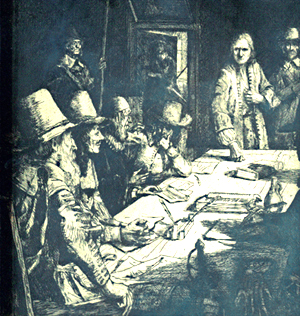 'We utterly deny all outward wars and strife and
'We utterly deny all outward wars and strife andfighting with outward weapons for any end or under any pretense whatever; this is our testimony to the whole world'
On the 21st November 1660 George Fox, founder of the Society of Friends, or Quakers, drew up a declaration for peace and presented it to the newly restored King, Charles II.
Fox's jounal indicates that the document was suppressed when he tried to publish it, saying that it was taken from the presses by the city authorities.
Notice how on the document, they refer to themselves as 'harmless and innocent' and say the declaration is against 'all plotters and fighters in the world.' These words are specifically to distance themselves from the Fifth Monarchists - a sect led by Thomas Venner who caused about forty deaths in an uprising in January of that year. In fact because of these uprisings the King outlawed Fifth Monarchists, Baptists and Quakers from holding public meetings and all members of these sects were required to take an Oath of Allegiance to the King.
The Fifth Monarchists were a radical religious movement that used both social and political pressure to effect their message and vision of a new religious "Golden Age" which they thought was about to begin, with the literal coming of the Messiah.
The riot began whenThomas Venner and his men wanted to gain control of St Paul's Church (then not a cathedral) and took his men to a bookseller called Mr. Johnson to demand the Cathedral keys. (Pepy's diary)
Upon being refused they broke in to the shop and accosted passers-by asking who they were for, presumably meaning whether they were for the King (Anglicanism) or for the non-conformists. One answered him "King Charles" and they dispatched him with a shot through the heart. A scuffle ensued and trained bands of soldiers had to be brought in by the monarchy to quell the unrest.
In later days Venner tried to storm the Comptor Prison to liberate the inmates so they could increase their ranks, but they were repulsed in fierce fighting. To give an idea of the brutality of fighting in these times, Venner is said to have killed three men with a halberd in Threadneedle Street.
TheFifth Monarchists made their last stand in two pubs, the Helmet Tavern on Threadneedle Street and the Blue Anchor on Coleman Street. Esconced inside they were only routed when Royalist troops smashed through the clay roof tiles with musket butts and fired down through the ceiling. Venner was captured after being wounded nineteen times, and put to death alomst immediately by hanging.
No wonder Fox and his colleagues sought to dissassociate themselves from Venner's sect.
 |
| George Fox at Holker Hall 1662 |
Since that time Quakers have kept their peace promise. I have often thought that in earlier times it must have been a much more difficult feat to achieve. In The Lady's Slipper the Quaker, Richard Wheeler, struggles with the pledge of non-violence. He lives in a society where disputes are settled by the sword. How will he fare when he has to defend the life of the woman he loves?
More about the Peace Declaration can be found here,
Picture from the Kendal Quaker Tapestry http://www.quaker-tapestry.co.uk


















No comments:
Post a Comment